
Tris Pharma, Inc., a biopharmaceutical company specializing in ADHD, pain, addiction, and neurological disorders, has announced new clinical data showcasing that cebranopadol, a dual nociceptin/orphanin FQ peptide (NOP) receptor and µ-opioid peptide (MOP) receptor agonist, causes significantly less respiratory depression compared to oxycodone. These findings will be featured in a poster session on August 7, 2024, at the IASP 2024 World Congress on Pain in Amsterdam.
New Study Highlights Cebranopadol’s Reduced Respiratory Depression Compared to Oxycodone
“The study results presented at IASP 2024 provide meaningful evidence that cebranopadol offers effective pain management with a lower risk of respiratory depression compared to oxycodone,” said James Hackworth, Ph.D., President of the Brand Division at Tris Pharma. “As a pioneering dual-NMR agonist, cebranopadol has the potential to minimize the side effects commonly associated with MOP agonists, as well as reduce the risks of abuse and dependence. This new data reinforces cebranopadol’s promise as a safer alternative to traditional opioids, and we are preparing to advance to Phase 3 trials shortly.”
Respiratory depression, a serious risk associated with opioid use, is mediated through the MOP receptor. The presented clinical study compared cebranopadol to oxycodone at supratherapeutic doses to assess their impact on respiratory depression, analgesia, potential dose ceiling effects, and overall safety. The double-blind, placebo-controlled trial involved 30 healthy volunteers over four weeks, receiving either cebranopadol, oxycodone, or a placebo.
Key Findings from IASP 2024
The IASP 2024 poster presentation, titled “Cebranopadol Effects on Ventilatory Drive, Central Nervous System, and Pain,” highlights several key findings:
- At equianalgesic doses, cebranopadol resulted in 25% less respiratory depression compared to oxycodone.
- Cebranopadol’s effects on respiratory parameters appeared later than oxycodone’s, allowing for a gradual buildup of arterial CO2 and reducing severe respiratory depression.
- Cebranopadol provided prolonged and gradual analgesic effects.
- Despite its longer duration of action, cebranopadol resulted in fewer respiratory adverse events, such as apnea and decreased oxygen saturation, over a 24-hour compared to oxycodone.
“The delayed onset of respiratory effects with cebranopadol is a key differentiator, potentially reducing MOP-related side effects typically seen with opioids,” said Dr. Albert Dahan, study author and Professor of Anesthesiology at Leiden University Medical Center. “These findings suggest that cebranopadol allows the body time to adjust its breathing, which could lead to safer and more effective pain management. Combined with previous studies, this data suggests a possible ceiling effect for respiratory depression in humans, advancing us toward a more effective treatment for both acute and chronic pain.”
About Cebranopadol (TRN-228)
Cebranopadol is an investigational, first-in-class dual-NOP and MOP receptor agonist designed for moderate-to-severe pain and opioid use disorder (OUD). Its unique mechanism leverages the NOP receptor to potentially reduce misuse risk while providing effective pain relief and blocking drug-seeking behaviors. The FDA has granted Fast Track Designation to cebranopadol for chronic low back pain. If approved, cebranopadol could become the first pain-relief therapy to offer opioid-equivalent efficacy with a significantly reduced risk of misuse, dependence, and overdose.
About Tris Pharma
Tris Pharma is a privately held, innovation-focused biopharmaceutical company dedicated to advancing treatments for ADHD, pain, and neurological disorders. With a strong portfolio of ADHD products and a promising pipeline of differentiated drug candidates, Tris leverages its drug development expertise and proprietary technologies to transform patient care.





